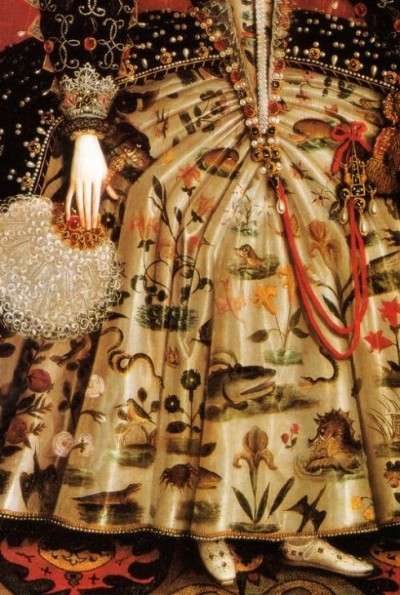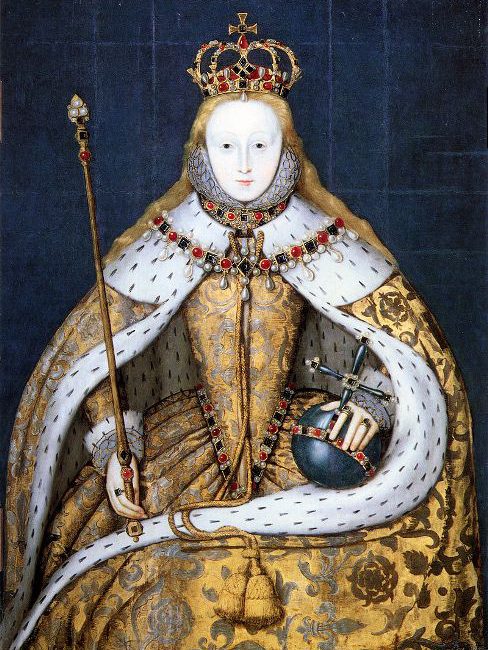On 15th January, 1559, Elizabeth I, the second queen regent in England and Henry VIII’s daughter by Anne Boleyn, was crowned Queen of England in Westminster Abbey. She inherited the throne from her elder sister, Queen Mary I, who died on 17th November 1558.

In those times, it was very important to have a monarch invested with power – to have him or her anointed and crowned – as soon as possible. Elizabeth used the recommendation of John Dee (an English born, Welsh mathematician, astronomer, astrologer, philosopher, and adviser to Elizabeth) and scheduled her coronation for 15th January, in about two months after Mary’s death.
On the 12th January, Elizabeth travelled to the Tower of London to prepare for her coronation.

It was probably difficult for her to be in this place, for Elizabeth had been a prisoner there only several years ago. Moreover, Anne Boleyn, Elizabeth’s mother, had been imprisoned in the Tower and had been executed on Tower Green. She might have tried to imagine the pain and distress which her mother had endured during the days of her imprisonment, and many despondent thoughts could have been running through her clever head.
On 14th January, the court gathered at the Tower, and the queen’s coronation procession began its way through the snow-covered streets of London.

Elizabeth was carried in a golden litter by two mules. Only twenty five years ago, Anne walked through the same streets with a light heart and a head full of dreams, thinking that she had carried a golden Tudor prince, not knowing that she would become ‘Anne of the Thousand days’, and having no idea that her child would be a better monarch than any son she could give Henry.
During the coronation procession, five pageantries took place. They aimed at stressing Elizabeth’s “Englishness” and creating a stark contrast to her sister’s “Spanishness”, including a contrast to Mary’s political alliance with Spain through her marriage to Philippe II of Spain and her Catholic beliefs.

According to Claire Ridgway, several pageants were a part of the coronation procession:
“1. Gracechurch Street – This pageant referred to Elizabeth’s genealogy, her Tudor roots and the history of the House of Tudor. The people were reminded that her name sake and grandmother Elizabeth of York had brought peace to the land by marrying Henry Tudor and uniting the warring Houses of York and Lancaster. Elizabeth, too, would bring peace and unity to the land.
2. Cornhill – This pageant referred to Elizabeth’s new government as being upheld by four virtues: True Religion, Love of Subjects, Wisdom and Justice.
3. Soper’s Lane – This pageant was based on the New Testament Beatitudes and, as Starkey explains, applied them to Elizabeth’s sufferings at the hands of her sister.
4. Little Conduit, Cheapside – This pageant with its subject of “Time” attacked Mary’s reign, contrasting “a decayed commonwealth” to “a flourishing commonwealth” in two tableaux. Time’s daughter, Truth, carried an English Bible labelled the “Word of Truth”, which Elizabeth’s government was said to possess. When Elizabeth saw this pageant, she asked for the Bible and “kissed it, and with both her hands held up the same, and so laid it on her breast, with great thanks to the City therefore.”
5. Fleet Street – This pageant depicted Elizabeth as the prophetess Deborah who had rescued Israel from Jabin, King of Canaan. Like Deborah, Elizabeth would reign over her people for over forty years.
The procession ended at Westminster in readiness for Elizabeth’s coronation ceremony the next day in Westminster Abbey.”

Elizabeth became “the people’s queen” , and her subjects rejoiced in her accession to the throne.
All along the streets, huge crowds of the common people and tradesmen gathered to greet and cheer their young queen. Elizabeth was attractive and graceful, welcoming them with a hearty smile on her face and charming them. Elizabeth and the nation already had “a marriage alliance” during her coronation: she owed her life to the undeniable support of the English people during Mary’s reign, and later she would say that “I have already joined myself in marriage to a husband, namely the kingdom of England”.

During those festivities, Elizabeth told the Lord Mayor:
“And whereas your request is that I should continue your good lady and be Queen, be ye ensured that I will be as good unto you as ever Queen was unto her people. No will in me can lack, neither do I trust shall there lack any power. And persuade yourselves that for the safety and quietness of you all I will not spare if need be to spend my blood. God thank you all.”

Anne Boleyn’s daughter conquered the hearts of her people, and now her path lay to Westminster Hall. Trumpets boomed, and then knights, lords, and heralds at arms appeared; then nobles and bishops in scarlet came, and in the end Elizabeth emerged in all her glory with all her footmen waiting on her. On that day, Westminster Hall was decorated with Henry VIII’s magnificent tapestries and his collection of gold and gilt plate.
Elizabeth was met by Nicholas Heath, Archbishop of York, for the Archbishop of Canterbury, Cardinal Pole, had already been dead, and so the duty to greet the queen fell to Heath. However, most of the English bishops were in a murky mood, growing increasingly suspicious of Elizabeth’s future religious policy. This gnawing and anxious undercurrent fed their suspicions to such a degree that Owen Oglethorpe, Bishop of Carlisle, was offered to crown Elizabeth despite of his low ecclesiastical rank.

Knights and nobles entered the abbey before the queen. Thomas Howard, 4th Duke of Norfolk and a cousin of Elizabeth’s, bore the crown. In his article about Elizabeth’s coronation, which was first published in May 1953, Dr. Alfred Leslie Rowse wrote about Elizabeth’s entrance to the abbey and her coronation:
“Then came the Queen, her train borne by her cousin on the Tudor side, the countess of Lennox, to whose issue the crown was to descend, for she was mother of Darnley, grandmother of James I. She was helped in holding up the train by the Lord Chamberlain, another of the Queen’s Howard cousinage – Lord Howard of Effingham a popular bluff fighting man, father of a more famous son. So they all passed into the Abbey, the people scrabbling for the blue cloth they had walked on, as soon as the Queen had gone by – the custom, apparently, at coronations.
Arrived, the Queen was placed in a chair of estate in the middle of the crossing, facing the high altar. At once the recognition – the first part of the coronation service – took place. She was conducted between two lords to be proclaimed by the bishop and acclaimed by the people in four directions – north, south, east, and west – the trumpets sounding at each proclamation. The two peers provided a nice symbolic contrast: Arundel, of the old Norman nobility, catholic and cultured; Pembroke, one of the newly risen Herberts, a doughty soldier, hardly literate but a great favourite with Henry, who had made him his immense fortune from the spoils of the Church.
Next come the offering: the Queen was led before the high altar and, kneeling before a bishop seated there, kissed the paten and made her offering of gold. Then seated in a chair before the altar she heard the sermon, preached by a bishop: we do not know who. After the sermon, the Queen now kneeling, came the bidding of the beads – i.e., the bidding of the people’s prayers – an old-established practice in England reaching back to earliest times, and of interest since it was the one part of the ceremony said in English amid all the other devotions said or sung in Latin.
There followed the administering of the customary oaths by the bishop to the Queen: to keep the laws and customs of England, to keep peace to the Church and people, to execute justice in mercy and truth. Here there stepped forward that symptomatic figure, Secretary Cecil, master-mind of the new regime, to hand a copy of the oaths to the bishop. What was he doing here? he was no ecclesiastic: I cannot but think this the most symbolic move in the whole show. Next came the most sacred moment of the ceremony – the consecration and anointing of the Queen. This was initiated by the singing of Veni, Creator and the Litany, and the saying of several long prayers. Previous sovereigns had endured this lying prostrate on cushions before the altar, and Mary had not been the one to omit it. Elizabeth politely knelt: no doubt she held that sufficient.
Now she was vested for the anointing; buskins, sandals and girdle put on, and over all a tabard of white sarsnet, the vestment called the colobium sindonis. Upon her head was placed a coif to protect the holy oil from running down – the coif, we know from the accounts, was of cambric lace; there were gloves of white linen and fine cotton wool to dry up the oil after the anointing. We do not know, but, presumably, Elizabeth was anointed in the five places usual then: palms of the hands, breast, between the shoulders, on the inside of the elbows, and lastly on the head. The anointing over, the Queen was invested and made ready for the delivery of the ornaments, the symbols of power. The gloves were presented to her by the lord of the manor of Worksop, who was the Earl of Shrewsbury – subsequently keeper of Mary Stuart and husband of Bess of Hardwick. The sword was offered to the Queen and redeemed by Arundel, as Lord Steward. Last came the delivery of the sceptre and the orb. Thus equipped, she was crowned, with all the trumpets sounding; and, though our account does not mention it, no doubt all the peers and peeresses put on their coronets at that moment.
After that came the homaging. The Queen had re-delivered the sword and laid it on the altar, and now returned to her chair of estate. The Bishop of Carlisle put his hand to the Queen’s hand and did homage first. Then followed the temporal peers first kneeling and then kissing the Queen; the bishops likewise. This was a reversal of the traditional order followed at Mary’s coronation: with that pious devote the Church came first; Elizabeth thought more of the temporal than of the spiritual.
When the bishop began the mass, the Queen was seated holding sceptre and orb. The epistle and gospel were read in both Latin and English, and the gospel was brought her to kiss. She then made her second offering, going to the altar, preceded by three naked swords and a sword in the scabbard. There she kissed the pax. But immediately upon the consecration of the elements beginning, it seems undoubted that the Queen withdrew to her traverse. Let us hope that she took the opportunity to have some refreshment, before the next stage, the procession to Westminster Hall for the banquet. She certainly changed her apparel and came forth in a ‘rich mantle and surcoat of purple velvet furred with ermines’.”

Elizabeth became Queen of England, and her coronation had a huge success. I like thinking that Anne Boleyn watched her daughter from Heaven: Anne triumphed over Henry VIII, and her soul could finally rest in peace.





